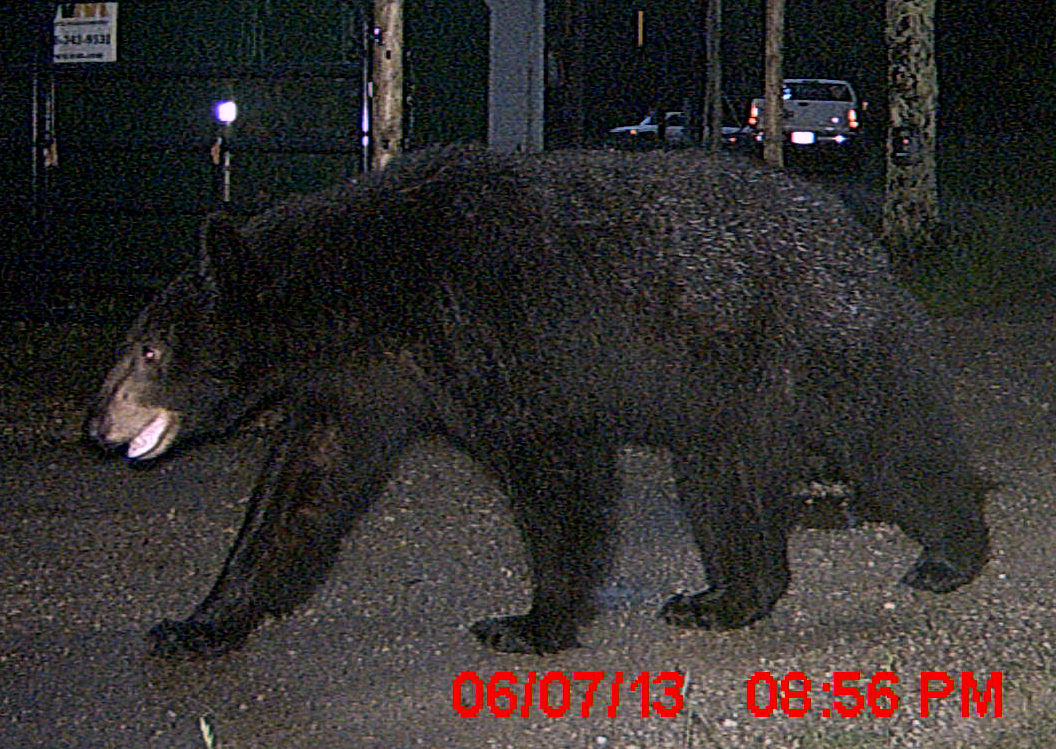Unfortunately, it would be both extremely difficult and inadvisable to have a live specimen of today’s organism on display. However, this is a species with which the station has had an unusual amount of contact recently. Despite being primarily an herbivore, the natural scavenging habits of black bears give them a propensity to investigate human dumpsters for the high-protein and high-fat foods which their diet often lacks. These bears are opportunistic omnivores—they tend to eat whatever is available to them. In the spring, they consume mainly small herbaceous plants and grasses; in the summer and fall they eat large quantities of roots and berries from a variety of plants and trees in preparation for the winter. Only a small part of their diet is composed of protein- and fat-rich animal matter, and even that is mostly insects with the occasional scavenged carrion.
 The black bear is the only bear in this area. They are residents of temperate and boreal forests across the continent, from the subarctic to the subtropical. However, they can also be found in wetland meadows, river areas, and mountains. Black bears are typically solitary animals which keep to their own large territories, with the exception of breeding pairs in the summer and female-cub groups. However, when food is abundant in a single location, large numbers of bears may cohabitate and develop a complex social structure. In such areas, groups of nonrelated members of the same sex can be found travelling or playing together. Black bears are highly intelligent, inquisitive creatures and have prodigious navigational skills which are, as yet, poorly understood.
The black bear is the only bear in this area. They are residents of temperate and boreal forests across the continent, from the subarctic to the subtropical. However, they can also be found in wetland meadows, river areas, and mountains. Black bears are typically solitary animals which keep to their own large territories, with the exception of breeding pairs in the summer and female-cub groups. However, when food is abundant in a single location, large numbers of bears may cohabitate and develop a complex social structure. In such areas, groups of nonrelated members of the same sex can be found travelling or playing together. Black bears are highly intelligent, inquisitive creatures and have prodigious navigational skills which are, as yet, poorly understood.
The territory of a male bear often overlaps with those of several females. Although bears typically mate in June through mid-July, the fertilized eggs are not implanted in the uterus until autumn. In January and February, around 220 days after conception, naked and blind bear cubs are born to the mother as she is hibernating in an underground den. At birth, they weigh 200-450 grams (½-1 lbs), making them the smallest young relative to adult size in any placental mammal. The 2-3 (but sometimes as many as 5) cubs nurse with their sleeping mother throughout the remainder of the winter, and by the time the family emerges in the spring, the cubs have increased their weight tenfold. Even after they are weaned by the age of 8 months, they typically continue to live with their mother (and share her den again the next winter) until she drives them from her territory the following spring in preparation for mating again. Females become sexually mature at 2-9 years old and usually mate every other year, while males mature in just 3-4 years. In the wild, black bears can live for 30 years, but most do not. 90% of the bears that die under the age of 18 die as a result of human interactions such as hunting, trapping, or collisions with vehicles.
In eastern North America, black bears are typically black in color, with paler muzzles and an occasional white chest spot. In the west, however, they can vary in color from brownish to blonde; in the far north, a few populations are creamy or blue-grey. They are, however, distinguishable from brown bears (Ursus arctos) by the possession of smaller shoulder humps and a convex, rather than a concave, profile. The bear pictured investigating the more powerful electric fence installed in its honor was one of two who has made a habit of visiting our dumpster in the last week. The images were captured on this past Friday and Saturday by a camera trap set up nearby.
Article by Hazel Galloway
Sources:
- Tom Mc Namara for setting up the camera trap and providing the images
- http://animaldiversity.ummz.umich.edu/accounts/Ursus_americanus/
- http://www.iucnredlist.org/details/41687/0
- http://animals.nationalgeographic.com/animals/mammals/black-bear/



